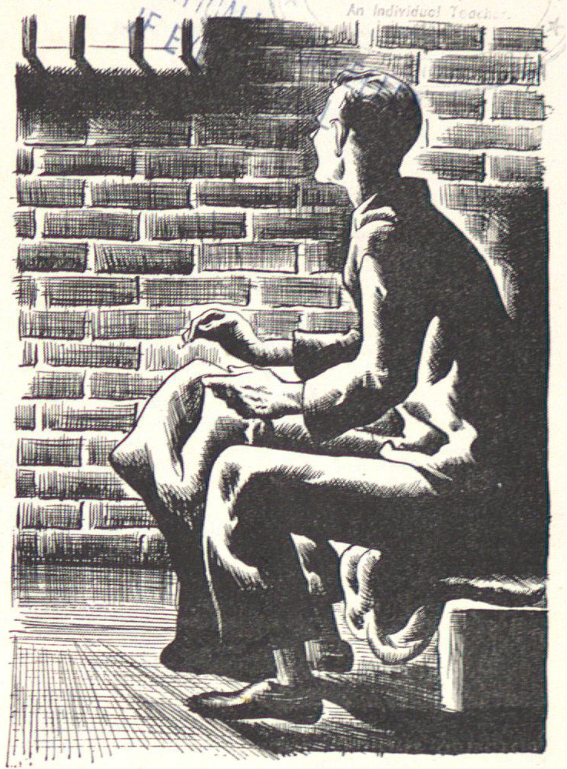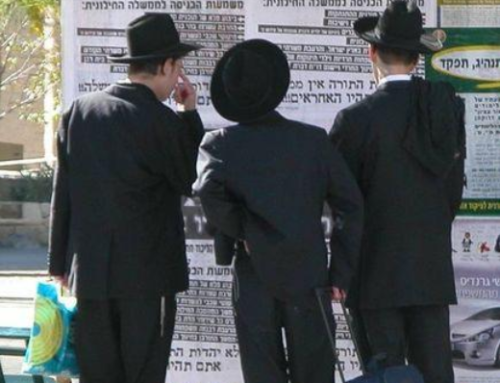
This image was produced by the Central Board of Conscientious Objectors in Second World War Britain and shows an imprisoned conscientious objector sewing mail bags.
In the midst of the Second World War, when millions of British citizens were mobilized to fight, Robin Jenkins registered as a conscientious objector. Jenkins was born in 1912 in a working-class coal mining town on the outskirts of Glasgow. His father died when he was a small child and Jenkins was brought up in relative poverty by his mother. As a teenage boy he won a scholarship to a fee-paying school and eventually studied Literature at Glasgow University, graduating in 1936 and becoming a teacher. After registering as a conscientious objector, Jenkins spent the rest of the war working in the forests of the west coast of Scotland. He was far from alone. Over sixty thousand British citizens registered as conscientious objectors to military service during the war of 1939-1945. Whereas those who opposed the First World War, and later the war in Vietnam, are sometimes held up as heroes – at least on the broadly liberal left – the COs of the 1930s and 1940s have a much more ambiguous position in popular memory, refusing to take up arms against fascism.
As Carole McGranahan and others have argued, acts of dissent and refusal can sever ties, but also create new ties, affiliations, and obligations (2016; Weiss 2016). And there is a particular tradition that runs through the protestant reformation, liberal constitutionalism, and certain forms of human rights activism, that makes conscience an archetypal and valorized form of dissent. Conscience here is seen as supplying the grounds for virtuous opposition, speaking from beyond narrow self-interest or instrumental calculation (Maclure and Taylor 2011; Rawls 1993). From such a perspective, the dissenting conscience represents not only the basis of individual freedom, but also the last residue of the ability to do good in the world in the face of otherwise overwhelming pressure. However, at the same time, a dissenting conscience can also appear egotistical and self-indulgent – perhaps even anti-social. The philosopher Susan Wolf, for example, has argued more broadly that a morally pure life seems to lack a human quality (1982). For Wolf, “moral saints” have no friends, family, lovers, comrades, or even acquaintances. They are unappealing to others, as they are not driven by affection and joy, but by a stark devotion. Conscience is therefore Janus faced – both valorized and mistrusted as the grounds for sociality.
After the war, Robin Jenkins became a famous and much-loved novelist, returning time and time again to themes of conviction and violence. We might see his writing as an attempt to make visible an otherwise intangible and private conscience. In the protestant tradition that was so strong in mid-twentieth century Scotland, conscience was private, individual, and often anxious. Giving conscience a textual form therefore helped make it legible. Jenkin’s writings can be treated as an ethnographic artifact of the dilemmas of conscience. The Cone Gatherers (1955), a classic of modern Scottish literature, is largely based on his experiences during the war, featuring several pacifist characters and reflections on the implications of violence. In the novel, conscientious objectors are a lurking presence in the background, never quite coming into view, but implicitly passing judgement on the events upon which the novel focuses. The social unease caused by conscientious objectors though can be most clearly seen in his later novel A Would Be Saint (1978). The novel tells the story of Gavin Hamilton, a Scottish conscientious objector, who provokes a mixture of respect and disdain from both the residents of the small town where he grows up and other pacifists. Gavin falls in love, but the relationship ends after he invites a homeless former prostitute to move in with him. The novel is implicitly partly autobiography, as Gavin Hamilton’s story follows Jenkins’ own trajectory from work-class town, to fee paying school, to conscientious objection and forestry work.
When the Second World War is declared Hamilton registers as a conscientious objector and is sent to a forestry unit in the damp west of Scotland, like Jenkins, where he lives in a hut with other pacifists. As the novel progresses, Hamilton becomes increasingly concerned that he should be forced to compromise on his principles. Eventually, Hamilton leaves the communal hut and moves further up the mountainside to sleep and eat alone. Throughout the book Hamilton’s friends and acquaintances are made uneasy in his presence. But, there is also some residual respect for his stances. One of his fellow conscientious objectors, says of other pacifists, “they had long ago put down their idealistic protest against the war… they lie awake at night, despising themselves for adding to the world’s falseness and hypocrisy. Then they remember Gavin and feel instantly absolved” (1978, 212).
In the last chapter of A Would-Be Saint, as the war ends and the conscientious objectors are allowed to go home, Hamilton goes missing. His fellow pacifists think he might have walked out into the wilderness to die, unable to live with others according to his deeply felt pacifist principles. They seem slightly disappointed when he eventually walks off the mountain. The critical response to Hamilton’s character in the book was equally ambivalent, although Jenkins himself was slightly confused by reaction, saying “somebody in the Times Literary Supplement said of Gavin that he was the most obnoxious hero she had read in modern fiction… I meant him to be a saint” (Murray 2006, 119).
Jenkins had written a novel based on his experiences, but the ambiguity of the response to conscientious objectors in the novel, and the critical response to the book, point to a wider anxiety around conscientious forms of dissent, seen as both a virtue and a vice. On the one hand, Lord Beveridge, the Cabinet Minister responsible for conscription in Second World War Britain, could declare in a radio broadcast that: “Admission of the right of conscientious objection to serve in war is the extreme case of British freedom. Nor have I any doubt that it makes Britain stronger in war rather than weaker” (Hayes 1949: 6). Yet, at the same time, a former chair of the British No-Conscription Fellowship, could be critical of conscientious objectors for being “far too often in the spirit of half arrogant pride” (Wilkinson 1986, 104). The most widespread criticism of conscientious objectors was not that they had refused to fight in time of war. Indeed, there was widespread support for the right of conscientious objection. Rather, the criticism was that conscientious objectors could be too committed to their own principles, somehow forgetting their own humanity.
The difficulties of living a socially meaningful conscientious life point to the problem of grounding commitments within a particular form of individualism. When conscience is understood as internal and autonomous, it also risks becoming unknown and unsocial. Claims of conscience therefore seek a mooring in collective life – in words as much as social action. But conscientious objection also seems to work against stable objectification in social life. We might even talk about the impossibility of living a liberally conscientious life with others. Perhaps no one captured this ambiguity better than Susan Sontag in her review of Simone Weil’s collected essays (1963). For Sontag, the “culture-heroes of our liberal bourgeois civilization are anti-liberal and anti-bourgeois; … of exemplary lives, there are those which invite us to imitate them, and those which we regard from a distance with a mixture of revulsion, pity, and reverence…. No one who loves life would wish to imitate (Weil’s) dedication to martyrdom nor would wish it for his children nor for anyone else whom he loves. Yet so far as we love seriousness, as well as life, we are moved by it, nourished by it.” What Sontag is getting at is the ways people can be both attracted and repulsed by claims of absolute moral virtue, which can seem both necessary for the world we want to live in, and somehow also anti-social. Conscientious dissent can therefore be seen as both the grounds for a vibrant sociality, and, at the same time, socially corrosive.
References
Hayes, Denis. 1949. Challenge of Conscience: The Story of the Conscientious Objectors, 1939-1949. London: Allen and Unwin.
Jenkins, Robin, 1955. The Cone Gatherers. Edinburgh: MacDonald.
Jenkins, Robin. 1978. A Would-Be Saint. Edinburgh: MacDonald
Maclure, Jocelyn and Charles Taylor. 2012. Secularism and Freedom of Conscience. Cambridge: Harvard University Press.
McGranahan, Carole. 2016. “Theorizing Refusal: An Introduction.” Cultural Anthropology 31 (3): 319–25.
Murray, Isabel (ed.). 2006. “Robin Jenkins.” In Scottish Writers Talking 3. Edinburgh: Joan Donald.
Rawls, John. 1993. Political Liberalism. New York: Columbia University Press.
Sontag, Susan. 1963. “Simone Weil.” New York Review of Books, February 1.
Weiss, Erica. 2014. Conscientious Objectors in Israel: Citizenship, Sacrifice and Trials of Fealty. Philadelphia: Pennsylvania University Press.
Weiss, Erica. 2016. “Refusal as Act, Refusal as Abstention.” Cultural Anthropology 31(3): 351-358.
Wilkinson, Alan. 1986. Dissent or Conform: War, Peace and the English Churches 1900-1945. York: SCM Press.
Wolf, Susan. 1982. “Moral Saints.” Journal of Philosophy 79 (8): 419-39.
Acknowledgments
The research upon which this essay is based was generously funded by an ERC Horizon 2020 Consolidator Grant (648477 AnCon ERC-2014-CoG).
Cite as
Kelly, Tobias. 2019. “Dissenting Conscience.” In Tobias Kelly, ed., “The Intimacy of Dissent,” American Ethnologist website, April 15, 2019. http://americanethnologist.org/features/collections/the-intimacy-of-dissent/dissenting-conscience.
Tobias Kelly is Professor of Political and Legal Anthropology at the University of Edinburgh.




